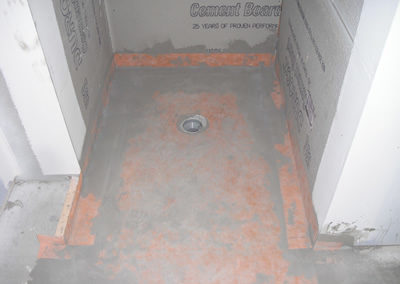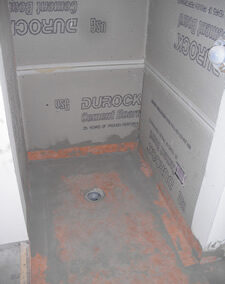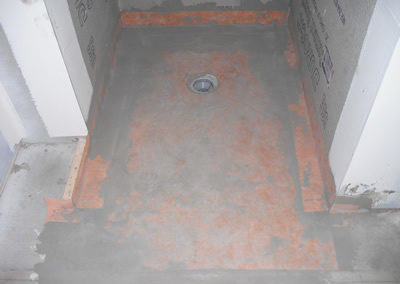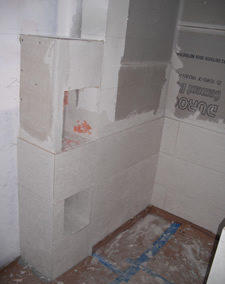Constructing a water-tight shower pan and drain is an art, but is arguably the most important step when installing a tiled shower during a bathroom renovation. Grout joints between tiles are not watertight, so water will inevitably leak through these joints to the shower pan below. Therefore, the shower pan must have a system whereby leaking water is channeled into the drain, without seeping through to the plywood subfloor.
Back in the boom years when demand for remodeling trumped the supply of skilled workers, showers were often slapped together with little or no concern for waterproofing. During the average month, we receive 2-3 calls from homeowners with leaking shower pans. Even if the offending shower has been remodeled recently (as is often the case), there is no quick fix for a faulty shower pan. The only way to repair this properly is to rip out the whole shower pan (down to the subfloor), and start again. This however, is another story for another day…..
As we do whenever we remodel a shower, we used the Schluter® System in the two master bathrooms at 753 to ensure that our shower pan and drain were watertight. As outlined on their website, “Schluter-KERDI was developed as a waterproofing membrane to be used in conjunction with ceramic and stone tile coverings. Tiles can be installed directly on Schluter-KERDI using the thin-bed method. The Schluter-KERDI-DRAIN is a floor drain specifically designed to allow connections to Schluter-KERDI or other load-bearing, bonded waterproof membranes, typically in shower applications. Schluter-KERDI is adhered to the drain’s large, trapezoid-perforated bonding flange, which is covered with a fleece webbing, to form a waterproof connection at the top of the drain assembly.”
We made the switch to Schluter systems several years ago. As a design-build firm, we were able to assemble a team of both designers and bathroom installers to study the merits of the various waterproofing systems available on the market. From a design standpoint, the choice was easy – using surface applied membranes allows for more flexibility in the design of shower systems, and thus improves the aesthetics of our bathrooms. Our build team decided that there were distinct advantages as well – longevity and ease of installation among them. The beauty of this system is that the watertight Kerdi membrane is set directly on top of the graded concrete shower pan as opposed to underneath the pan (directly on the subfloor) as was once the preferred method.
Once we poured our pan (sloped at least ¼ inch per foot), we applied un-modified thin set mortar with the recommended v-notch trowel, and applied the Kerdi membrane. Special care was taken to maintain the correct overlap on both the corners and the edges to ensure a correct bond. The tile will be applied directly over the membrane.
Our advice for homeowners considering a bathroom remodel: Whether you will be performing the renovation yourself, or hiring a general contractor, make sure that the proper attention is paid to waterproofing. A superficial understanding of waterproofing techniques can render even the most beautifully designed bathroom unusable in a matter of weeks.



